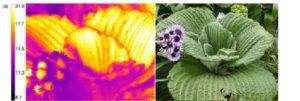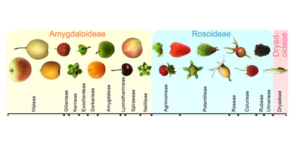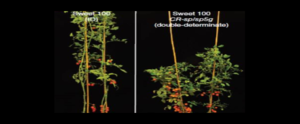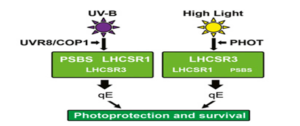Scientific American: All 2.3 Million Species Are Mapped into a Single Circle of Life
“Researchers from a dozen institutions recently completed a three-year effort to combine tens of thousands of trees into one diagram, most readable as a circle. The lines inside the circle represent all 2.3 million species that have been named. Biologists have genetic sequences for only about 5 percent of them, however; as more are finished, the relationships within and across groups of species may change. Experts estimate that up to 8.7 million species may inhabit the planet (about 15,000 are discovered every year). “We expect the circle to broaden,” says Karen Cranston, a computational evolutionary biologist at Duke University.”


 Plants from the Solanaceae family had, and continue to have, fundamental roles in plant genetic research. Gebhardt summarizes the historical contributions of the Solanaceous plants tomato, tobacco, petunia, potato, pepper, and eggplant. The tomato has been a model plant for studying fruit traits such as sugar content. Fruit traits, including size, shape, and capsaicinoid content, have also been studied in the pepper plant, and the pepper has been useful for identifying resistance genes for bacterial and viral infections. Tobacco was crucial for understanding regeneration of plants from undifferentiated cells and stable transformation using the Ti plasmid from Agrobacterium. Petunia was used to study the genetics of flower morphology, pigmentation, and development. The potato is uniquely suited for studying the genetics of tuber development, and the potato genome was useful for constructing genetic linkage maps to compare genome structures before the era of high-throughput sequencing. The eggplant is an under-utilized Solanaceous plant, although a draft genome sequence was published in 2014. The agronomic impact from the genetics of Solanaceous plants has come from identifying genes responsible for pathogen resistance and for desirable phenotypes, such as fruit color. The Solanaceae family has central roles in both establishing plant genetics in the first half of the twentieth century and advancing plant genomics in recent decades. (Summary by
Plants from the Solanaceae family had, and continue to have, fundamental roles in plant genetic research. Gebhardt summarizes the historical contributions of the Solanaceous plants tomato, tobacco, petunia, potato, pepper, and eggplant. The tomato has been a model plant for studying fruit traits such as sugar content. Fruit traits, including size, shape, and capsaicinoid content, have also been studied in the pepper plant, and the pepper has been useful for identifying resistance genes for bacterial and viral infections. Tobacco was crucial for understanding regeneration of plants from undifferentiated cells and stable transformation using the Ti plasmid from Agrobacterium. Petunia was used to study the genetics of flower morphology, pigmentation, and development. The potato is uniquely suited for studying the genetics of tuber development, and the potato genome was useful for constructing genetic linkage maps to compare genome structures before the era of high-throughput sequencing. The eggplant is an under-utilized Solanaceous plant, although a draft genome sequence was published in 2014. The agronomic impact from the genetics of Solanaceous plants has come from identifying genes responsible for pathogen resistance and for desirable phenotypes, such as fruit color. The Solanaceae family has central roles in both establishing plant genetics in the first half of the twentieth century and advancing plant genomics in recent decades. (Summary by  High latitude and altitude plants experience short growing seasons, consistent low temperatures, windy environments and unpredictable sunny spots. These plants are usually small and rely on self-pollination, but in Campbell, a Sub-Antarctic island, there are gardens of megaherbs that defy the predictions of what the flora should be according to the environment. Little et al. show that these megaherbs evolved large, corrugated and hairy leaves that keep the warmth in the boundary layer after brief sun exposure and, in addition, compact flowers with bright, dark colors that also stay warm and attract the few species of pollinators present in the island. Leaf and floral temperatures are correlated with light intensity and the mechanism by which the plants keep warmth don’t seem to be thermogenesis. This is also an excellent example of convergent evolution where flora of far away places (tropical alpine and Sub-Antarctic environments) developed similar structures to minimize damage by extreme cues and maximize metabolic rates. (Summary by
High latitude and altitude plants experience short growing seasons, consistent low temperatures, windy environments and unpredictable sunny spots. These plants are usually small and rely on self-pollination, but in Campbell, a Sub-Antarctic island, there are gardens of megaherbs that defy the predictions of what the flora should be according to the environment. Little et al. show that these megaherbs evolved large, corrugated and hairy leaves that keep the warmth in the boundary layer after brief sun exposure and, in addition, compact flowers with bright, dark colors that also stay warm and attract the few species of pollinators present in the island. Leaf and floral temperatures are correlated with light intensity and the mechanism by which the plants keep warmth don’t seem to be thermogenesis. This is also an excellent example of convergent evolution where flora of far away places (tropical alpine and Sub-Antarctic environments) developed similar structures to minimize damage by extreme cues and maximize metabolic rates. (Summary by  The evolution of fruits might have been the most important feature that made angiosperms so successful. Fruits protect seeds and contribute to seed dispersal, as well as comprise a food source for humans and other animals, therefore, studying their evolution would help us shed light on the evolution of angiosperms themselves and also understanding their ecological implications. In their paper, Xiang et al. take us through their reconstruction of the Rosaceae family tree by using nuclear phenology after sequencing the transcriptomes of 123 species in this family (plus some outgroup species), and show us the importance of the role of whole genome duplications not only in speciation but also on the diversification of the family’s fruit types. (Summary by
The evolution of fruits might have been the most important feature that made angiosperms so successful. Fruits protect seeds and contribute to seed dispersal, as well as comprise a food source for humans and other animals, therefore, studying their evolution would help us shed light on the evolution of angiosperms themselves and also understanding their ecological implications. In their paper, Xiang et al. take us through their reconstruction of the Rosaceae family tree by using nuclear phenology after sequencing the transcriptomes of 123 species in this family (plus some outgroup species), and show us the importance of the role of whole genome duplications not only in speciation but also on the diversification of the family’s fruit types. (Summary by  Tomatoes have an indeterminate growth pattern that arises from the balance of flower-promoting (florigen) and flower repressing activities. Suppressing this flower-repressing activity leads to greater determinacy and facilitates cultivation. Soyk et al. compared flowering times in short- and long-days in close relatives of domesticated tomato, with a QTL analysis revealing two related genes, SFT (encoding florigen) and SP5G. Null alleles of SP5G, generated by CRISPR/Cas9, showed significantly earlier flowering in long days. Combining this with a mutation in the flower-repressing SELF PRUNING (SP) gene led to even greater determinacy, translating to an early crop yield. This paper shows the potential of gene-editing to rapidly and specifically alter plant growth patterns and yields. Nature Genet.
Tomatoes have an indeterminate growth pattern that arises from the balance of flower-promoting (florigen) and flower repressing activities. Suppressing this flower-repressing activity leads to greater determinacy and facilitates cultivation. Soyk et al. compared flowering times in short- and long-days in close relatives of domesticated tomato, with a QTL analysis revealing two related genes, SFT (encoding florigen) and SP5G. Null alleles of SP5G, generated by CRISPR/Cas9, showed significantly earlier flowering in long days. Combining this with a mutation in the flower-repressing SELF PRUNING (SP) gene led to even greater determinacy, translating to an early crop yield. This paper shows the potential of gene-editing to rapidly and specifically alter plant growth patterns and yields. Nature Genet.  Light is good, too much light is bad. Photosynthetic organisms can dissipate excess light through a variety of means including non-photochemical quenching. Czechowski et al. show that in Chlamydomonas perception of UV-B light via the nuclear/cytosolic receptor UVR8 induces accumulation of proteins that contribute under high light conditions to non-photochemical quenching and the dissipation of excess light as heat. This study shows an example of anterograde signaling from the nucleus / cytosol to the plastid, and can contribute to efforts to improve crop efficiency through decreasing photoinhibition. Proc. Natl. Acad. Sci. USA
Light is good, too much light is bad. Photosynthetic organisms can dissipate excess light through a variety of means including non-photochemical quenching. Czechowski et al. show that in Chlamydomonas perception of UV-B light via the nuclear/cytosolic receptor UVR8 induces accumulation of proteins that contribute under high light conditions to non-photochemical quenching and the dissipation of excess light as heat. This study shows an example of anterograde signaling from the nucleus / cytosol to the plastid, and can contribute to efforts to improve crop efficiency through decreasing photoinhibition. Proc. Natl. Acad. Sci. USA